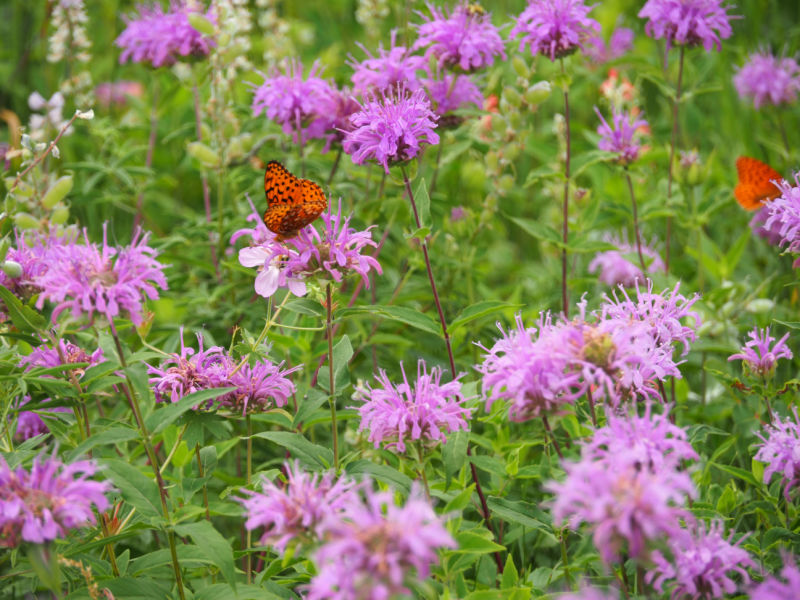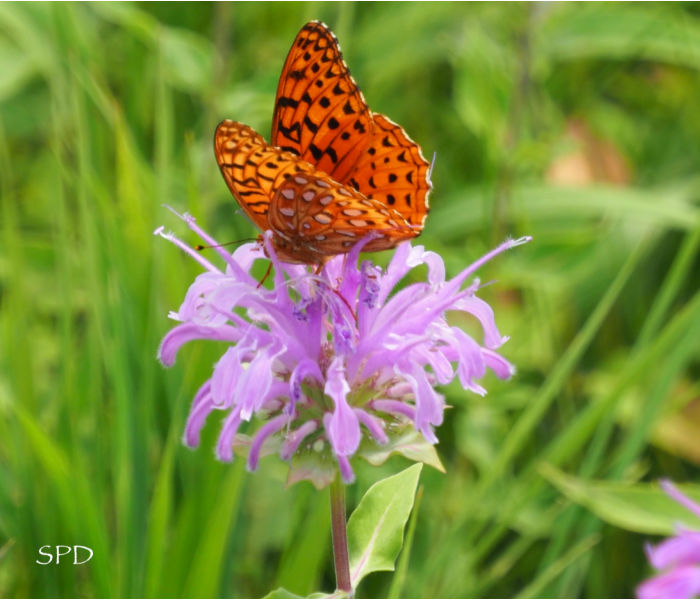
Wild bergamont (Monarda fistulosa) attracts an Aphrodite fritillary butterfly
Wild Bergamot is abundantly in bloom right now, covering the hills with exuberant bursts of purple, scenting the air nearby with gentle fragrance, and generously providing nectar to a variety of equally colorful pollinators. Thank goodness several speakers giving CoNPS (Colorado Native Plant Society) webinars this winter reminded us that it’s not just rare plants we need to be valuing and conserving – common plants have equally important roles. Common plants often act as a vital component, or anchor, for an ecosystem. They can support a larger number of wildlife than rare plants, they have wider adaptability of course, which is becoming ever more critical, and they are the ‘pioneer’ species that come in first to repopulate a devastated area. Thus, despite the fact that it is not rare, we are justified in celebrating the beauty and utility of Monarda fistulosa, wild bergamot!
There are several species of Monarda, and the many common names associated with them, bee balm and horsemint among them, are applied in a confusing mix-up among different geographical regions – ample reason for knowing the scientific name, which belongs exclusively to just one plant. Only two Monardas are native to Colorado, Monarada fistulosa, and Monarda pectinata, the latter being distinguished by its stacked presentation of flowers on an interrupted spike. The genus name Monarda was given by Linneaus to honor a Spanish physician, Nicholas Monardes, who published books on medicinal plants in the 16th century; the species name, fistulosa, means hollow or reed-like, referring to the plant’s hollow stem.
As its name may suggest, wild bergamot, like most members of the Lamiaceae family (the mint family) is aromatic, but it is not the source of the bergamot flavor in Earl Grey tea, which comes from a citrus fruit grown in Italy, Citrus bergamia, the Bergamot orange. Its resemblance to the scent of this fruit is the reason wild bergamot got its common name. It is possible, however, to enjoy a pleasant tea made from the dried or green leaves or the seed heads of wild bergamot.
The flower’s scent comes from monoterpenes, which are essential oils contained in tiny sacs on the leaves and flowers. When these are broken by being rubbed against their scent is released. While humans use these essential oils as fragrances, medicines, and flavors, plants have their own ideas, putting them to use suppressing other plants, repelling herbivores, and attracting pollinators and seed dispersers.
The lavender to pink and occasionally white flowers of the M. fistulosa form a ring on dense head-like cymes which bloom from the center outwards. What appears to be a single flower is actually a cluster of many smaller blossoms. The lobes and exserted stamens of these individual flowers give an amusingly raggedy and somewhat whimsical appearance to the flower head. In Colorado wild bergamot will bloom for at least a month and sometimes longer.
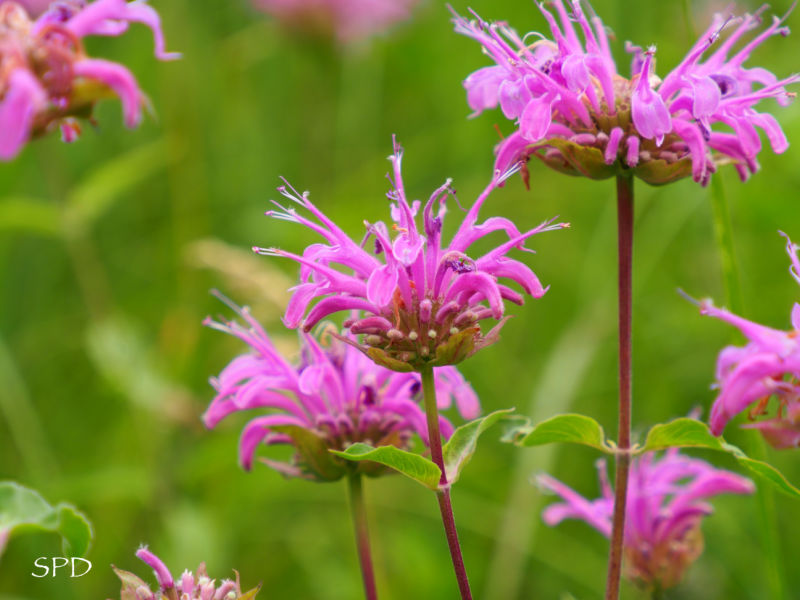
Cymes of Mondarda fistulosa are made up of numerous individual flowers with exserted cymes.
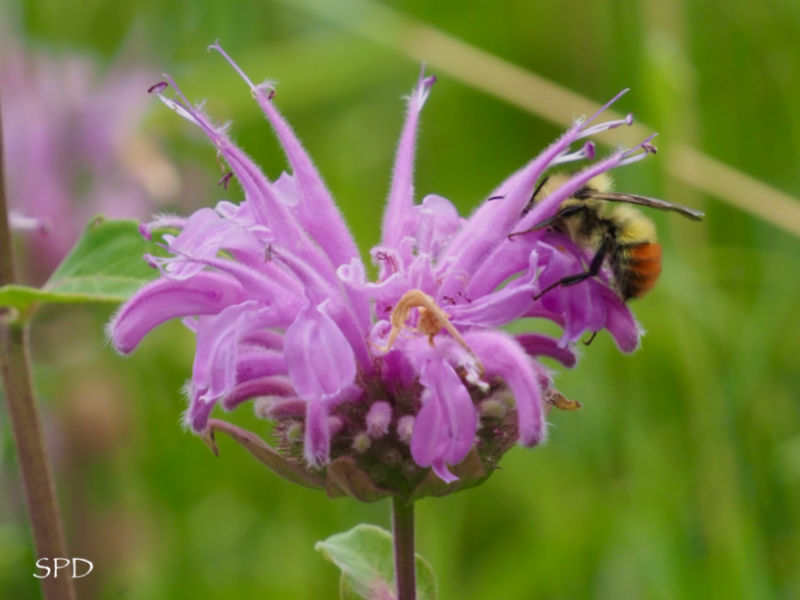
Wild bergamot is highly attractive to native bees.
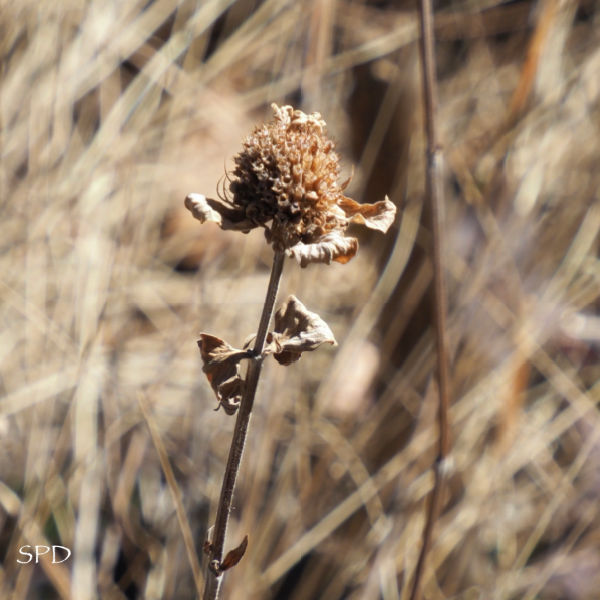
Monarda fistulosa seed head in fall. Seeds eaten by goldfinches and field sparrows.
The seed heads also give wonderful winter interest with the tubular dried calyxes of the individual flowers forming a warm tan, firmly textured, rounded head. Four small nutlets form in the base of each calyx tube, enjoyed by small seed-eatiing birds like goldfinches and field sparrows. The dried stalks look nice in winter bouquets and are still exuding a light fragrance
Best of all Monarda fistulosa is easy to grow and a true pollinator magnet. It attracts a steady stream of butterflies – swallowtails, skippers, fritillaries, and sulphurs. It’s a favorite of moths like the Clearwing, of Ruby-throated hummingbirds, and also of native bees. It performs best in full sun but tolerates light shade, is considered a low-water-needs
plant, standing up well to drought, and is not a favorite of deer or rabbits. It spreads by slender underground rhizomes, forming clumps over time. Divide in late winter or early spring before new shoots appear every three or four years for vigorous blooming.
Just another extraordinary common native plant!
Sue Dingwell

